Game 8: One Misplaced Pawn May Have Just Clinched The World Chess Championship
Oliver Roeder
FiveThirtyEight
https://fivethirtyeight.com/features/one-misplaced-pawn-may-have-just-clinched-the-world-chess-championship/
December 5, 2021
We didn’t see much of Ian Nepomniachtchi on Sunday, though the Russian grandmaster is nominally competing for the World Chess Championship in Dubai. He spent much of the day in a private room, hidden away from spectators and cameras, while the chess world watched his position deteriorate on the board.
Magnus Carlsen of Norway, the defending champion, played largely alone, and he took a commanding lead in the match, thrashing Nepomniachtchi in 46 relentless moves over four hours. Carlsen, who has held the world title since 2013, now leads 5-3 in a race to 7.5 points.
Sunday’s Game 8 saw the players begin in the Petrov defense, revisiting the early moves of Game 4. Eager knights jousted on a narrow tiltyard, quickly knocking each other out of play. After eight moves, the position was perfectly symmetrical, with a parade of pieces strung up the board.
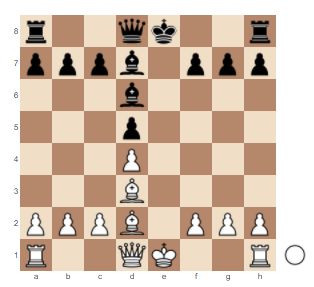
This lovely arrangement appears 11 times in ChessBase’s database, historically leading to five wins for white and six draws, though it had only been played before by amateurs. Symmetrical positions rarely lead to symmetrical results at the highest levels, and the parade did not appeal to Nepomniachtchi, who had the black pieces — he grimaced, stared into space and buried his head in his arms.
Both grandmasters dug in for a fight, and it wasn’t lovely for long.
In the position above, Carlsen castled and Nepomniachtchi ventured a pawn h5, an unnatural-looking but bold move, representative of lessons recently taught to humans by advanced neural networks. Both players eschewed lines that appeared drawish, and all across the board, Carlsen began to accumulate the tiny edges he is famous for pursuing.
When Nepomniachtchi did appear in his chair, he moved quickly. On his 21st move, he moved his pawn forward to the b5 square, as shown below, pressuring Carlsen’s bishop and likely handing Carlsen the world championship.
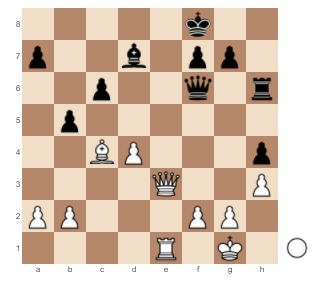
In a match defined by accuracy, with so many moves earning the annotator’s exclamation point, this was roundly given a question mark or two. It blunders away a pawn: Carlsen moves his queen to a3, putting Nepomniachtchi in check. After the black king slides to safety, Carlsen grabs the pawn on a7 while invading Russian territory with his queen.
After this, Nepomniachtchi disappeared.
Carlsen stood up and prowled the board.
Nepomniachtchi reappeared, made another reckless move,1 and disappeared again.
The Norwegian’s advantage grew to two pawns and then three, and converting such an edge is elementary for a super grandmaster. After a master class of Carlsen’s exacting endgame play, Nepomniachtchi reappeared to offer his hand in resignation. After the game, Nepomniachtchi called his play “a chain of slightly weird decisions” and apologized for his performance.
With six games remaining, the path to victory now for Nepomniachtchi is very narrow and very steep. The Chess by the Numbers model gives Carlsen a 98.5 percent chance to retain his title and cement his status as the greatest of all time.
In a match defined by accuracy, with so many moves earning the annotator’s exclamation point, this was roundly given a question mark or two. It blunders away a pawn: Carlsen moves his queen to a3, putting Nepomniachtchi in check. After the black king slides to safety, Carlsen grabs the pawn on a7 while invading Russian territory with his queen.
After this, Nepomniachtchi disappeared.
Carlsen stood up and prowled the board.
Nepomniachtchi reappeared, made another reckless move,1 and disappeared again.
The Norwegian’s advantage grew to two pawns and then three, and converting such an edge is elementary for a super grandmaster. After a master class of Carlsen’s exacting endgame play, Nepomniachtchi reappeared to offer his hand in resignation. After the game, Nepomniachtchi called his play “a chain of slightly weird decisions” and apologized for his performance.
With six games remaining, the path to victory now for Nepomniachtchi is very narrow and very steep. The Chess by the Numbers model gives Carlsen a 98.5 percent chance to retain his title and cement his status as the greatest of all time.
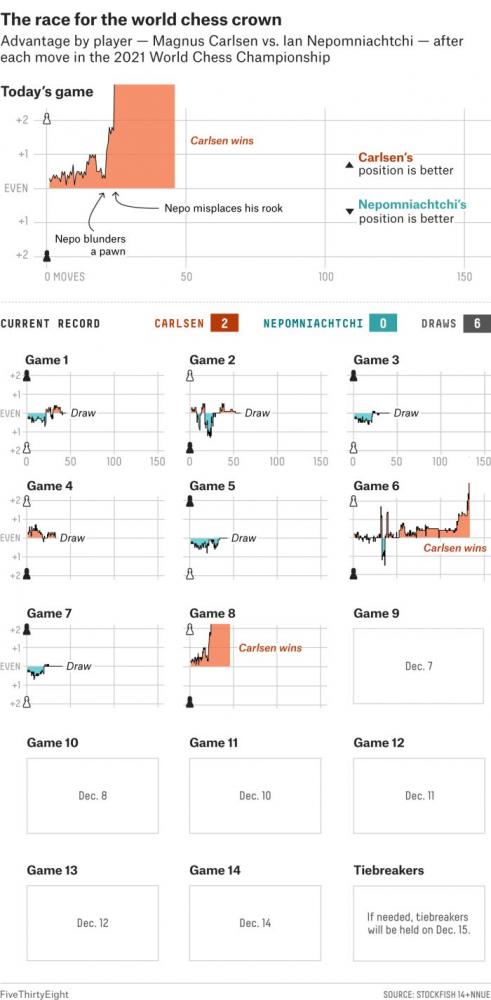
The match rests tomorrow, and Game 9 begins Tuesday at 7:30 a.m. Eastern. We’ll be covering it here and on Twitter, prowling the keyboard.
♦♦♦ ♦♦♦ ♦♦♦
Game 6: How The Longest Game In World Chess Championship History Was Won
Oliver Roeder
FiveThirtyEight
https://fivethirtyeight.com/features/how-the-longest-game-in-world-ches…
December 3, 2021
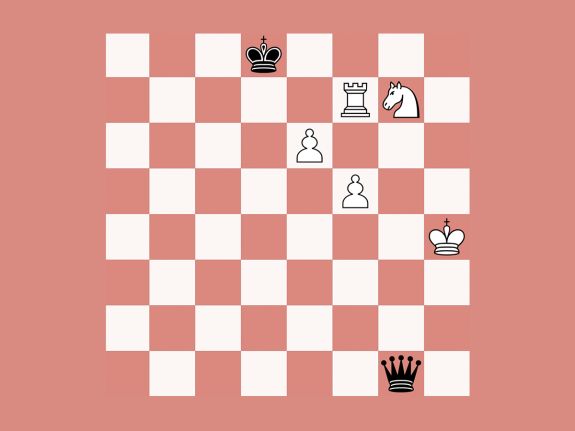
Final position Game 6 -- First win of 2021 Championship
Ian Nepomniachtchi took off his blazer on the third move, a record-fast time, and he played with a captured chess piece like it was a fidget spinner. Across the table from him in a glass box in Dubai sat Magnus Carlsen, the world No. 1. The two, locked in the middle of a weeks-long battle for the World Chess Championship, would be sitting there for a while. More than eight hours later, at the postgame press conference with his jacket back on, Nepomniachtchi would wonder what had gone wrong.
Within a few moves, Carlsen offered to sacrifice a pawn on the altar of attack, a gambit he had tried twice before in the match, which had yet to see a win. It was a creative idea, celebrated by the commentating experts, in this version of the Catalan opening, territory they had also visited last weekend in Game 2.
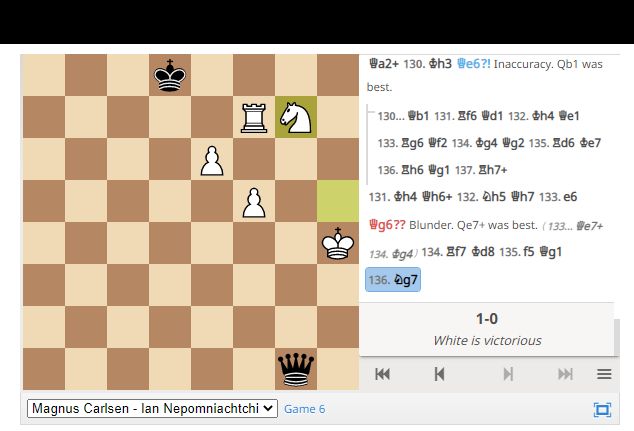
Click HERE to playout the entire Game 6 move by move
Nepomniachtchi declined the pawn and offered his own piece of aggression. Chess analysts offer a variety of punctuation for notable moves. Nepomniachtchi’s 11th move was universally awarded an exclamation point — with “11 … b5!” he successfully navigated the opening with the black pieces and bared his teeth, showing his own willingness to do battle. A few moves later, Nepomniachtchi declined to trade queens, again demonstrating his tenacity. Two entrenched, well-equipped armies stared at each other across an empty no-man’s land in the middle of the board — the silence before the fury and long war of attrition to come.
Nepomniachtchi soon offered a trade of his own — one white queen for two blacks rooks. Carlsen accepted these terms, and the imbalanced position teetered precariously on the board. The players’ clocks ticked while they contemplated how it might all crash down.
Players begin world championship games with a bank of two hours — they gain a bonus hour only once they make their 40th move. If a player’s clock reaches 0:00, they lose. By the 30th move, Carlsen’s clock had drifted below 10 minutes. By the 35th, both his and Nepomniachtchi’s clocks were under five minutes.
For so much of the match, the computer evaluation had sat level near 0.00, representative of the dead-equal and nearly perfect chess played by both grandmasters. During this feverous stretch of time trouble that followed here, however, the computer twitched like a seismograph during the Big One.
Clocks draining, Carlsen and Nepomniachtchi were locked in an intricate battle for space and material in the board’s southwest corner — an asymmetric skirmish, queen and bishop versus rooks and knight. Carlsen was the first to see real winning chances, but he missed a chance to spring a fruitful long-distance attack on the black king. (Carlsen said after the game that this idea hadn’t been on his radar.) Shortly thereafter, Nepomniachtchi ought to have grabbed a free pawn but did not.
They each made their 40th moves with mere seconds to spare, the computer once again displayed 0.00, and the clocks wound to an hour apiece.
But four hours into play, there was still a rich, fraught endgame to come. With his king safely tucked away and some time on his clock, Carlsen was free to investigate his attacking chances once again.
A painstaking dance unfolded over dozens of moves, as a few pawns were gobbled up and pieces rerouted to just the right places. On the 80th move, Carlsen traded one of his rooks for a pawn and bishop, and the survivors were as follows: a rook, a knight and three pawns for Carlsen; a queen and one pawn for Nepomniachtchi.
It was some 30 moves before another pawn was moved, and no pieces were captured, as the bigger guns bobbed and weaved, darting in and out of traffic, and with similar consequences should they not look both ways. By the 100th move, Nepomniachtchi’s chair was shaking visibly, another seismic event. As moves crept further into triple digits, Carlsen started checking his scoresheet, wanting to avoid the threefold repetitions of position that would be declared a draw, and instead pursue victory, however long it took.
By the 116th move, the game could be found in endgame tablebases, those precalculated positions made known by modern machines — the game was a theoretically guaranteed draw. That doesn’t mean the draw is easy for a human to achieve. Nepo had to navigate a minefield while taking on heavy fire, finding just the right moves to hold the draw, while Carlsen was playing essentially without risk.
On the 125th move, it became the longest game in world championship history.
On the 130th move, Nepomniachtchi put a foot wrong. A powerful computer analyzing the match found a guaranteed checkmate 60 moves into the future.
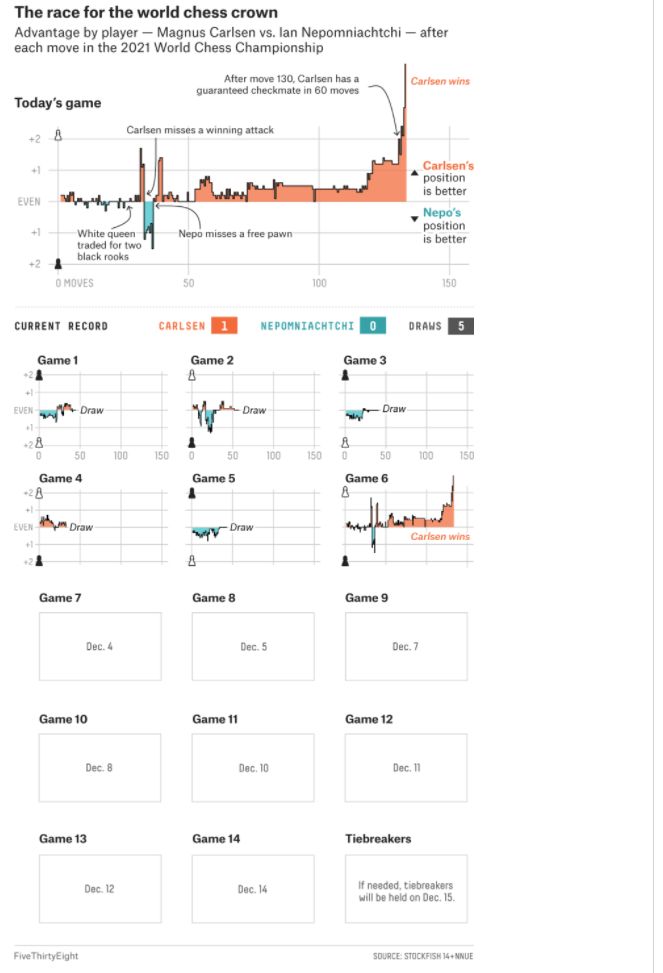
It wouldn’t take quite that long. Nepomniachtchi offered his hand in resignation after 136 moves over nearly eight hours, as Carlsen’s pawns were unstoppable, bound for promotion at the far end of the board. Carlsen now has the lead in the best-of-14-game match, 3.5-2.5, and the contest could stretch until mid-December.
In a match defined by flawless play, a few human mistakes on Friday introduced deep drama and turned the game into an instant classic. Nepomniachtchi described the play of both players as “far from excellent,” but the game itself was superb.
“I was running on fumes at the end,” Carlsen said at the postgame press conference, chalking the game up as win like any other, with familiar nonchalance.
And how does Nepomniachtchi bounce back? “Hopefully in style,” he said.
The match continues through the weekend, with Game 7 on Saturday and Game 8 on Sunday — both begin at 7:30 a.m. Eastern. We’ll be covering it here and on Twitter, keeping a close eye on our clock.
Oliver Roeder is a journalist and author in New York City. Recently, he has been a Nieman Fellow at Harvard studying artificial intelligence, and a senior writer and the puzzle editor at FiveThirtyEight. Find him on Twitter or send him an email. He is especially interested in games and competitive subcultures, political strategy, art and its market, and our artificially intelligent future. He holds a PhD in economics with a focus on game theory. Sometimes he writes crossword puzzles.
He is the author of:
Seven Games: A Human History (W.W. Norton, forthcoming Jan. 2022) -- for millennia, human beings have played games. For decades, computer scientists have developed artificial intelligence to beat the best human players—in checkers, chess, Go, backgammon, poker, Scrabble, and bridge, among others. This book is a narrative history of that human-machine collision and the battles for gaming supremacy. It is also an essay on what artificial intelligence and games mean for our species and its future.
The Riddler: Fantastic Puzzles from FiveThirtyEight (W.W. Norton, 2018) -- A collection of his weekly math columns and the first book under the FiveThirtyEight banner. Will Shortz called it “a modern, smart puzzle book, unlike anything I’ve seen before, whose math and logic challenges will stretch your brain in new ways.”
Five ThirtyEight covers sports, politics and science. We use data and evidence to advance public knowledge — adding certainty where we can and uncertainty where we must.

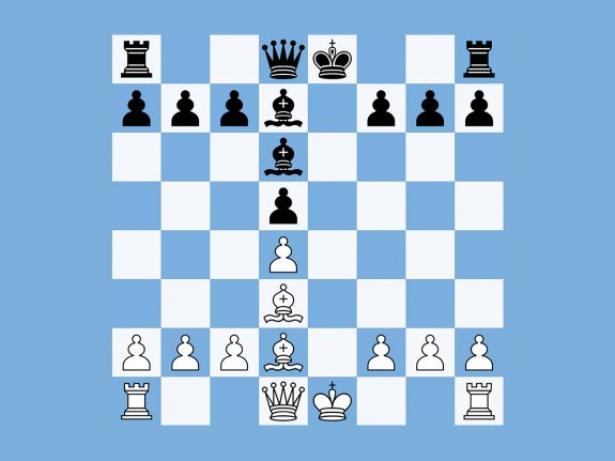
Spread the word